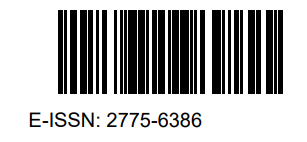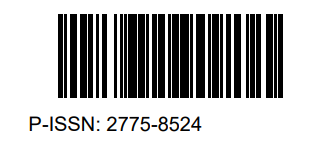THE MYTH OF THE RAT AND THE RAT MAN IN WES ANDERSON’S THE RAT CATCHER
DOI:
https://doi.org/10.33477/lingue.v7i1.9349Keywords:
claude levi-strauss, myth, the rat catcher, wes andersonAbstract
This study aims to understand the myth of the rat and the 'Rat Man' through their behavior in the film The Rat Catcher. The research employs a qualitative method with data collection through note-taking. The researcher watches the film and records dialogues related to the research theme. The data analysis technique is conducted by analyzing the dialogues and behaviors in The Rat Catcher1 in relation to the concept of myth within Claude Levi-Strauss's structuralism. Myths are often associated with events in society that influence customs or lifestyles of those who believe in them. Through Levi-Strauss's structuralist analysis, it was found that the failure of the Rat Man to catch the rat highlights the irony of the myth. The various methods he employs to catch the rat, ranging from ordinary to unique and even extreme, yield no results. In conclusion, the Rat Man remains trapped in an illusion that does not prove the myth he believes in, thus the myth about the rat continues to linger in his mind. The contribution of this study is to provide an understanding of how the myths of the rat and the 'Rat Man' can be analyzed through the lens of Claude Levi-Strauss's structuralism to reveal the irony and failure in the application of these myths.
References
Adijaya, S. (2024). Pemikir-Pemikir Besar Antropologi. Uwais Inspirasi Indonesia.
Afifa, K. S., & Nugraha, A. S. (2023). Mitos dalam Kajia Strukturalisme Levi Strauss. Prosiding Seminar Nasional Pendidikan Bahasa dan Sastra Indonesia(Senapastra), 120–128.
Anderson, W. (2023). The Rat Catcher [Video recording]. Netflix.
Buchanan, K. (2023). Roald Dahl’s Prose, Spoken in Character. The New York Times.
da Silva, G. R., & Werneck, M. M. F. (2021). Claude Levi-Strauss and the myth Anamorphoses. Revista Avesso: Pensamento, Memória e Sociedade, 2(1), 1–17. https://doi.org/https://doi.org/10.23925/2675-8253.2021v2IiT1.
Das, S. (2023). The Rat Catcher review: Wes Anderson cunningly adapts Roald Dahlshortstory. https://www.hindustantimes.com/entertainment/hollywood/the-rat-catcher-review-wes-anderson-cunningly-adapts-roald-dahl-short-story-101696236194424.html.
De la Prida, R. (2022). Mise-en-abyme as narrative strategy in the films of Wes Anderson. Quarterly Review of Film and Video, 39(8), 1767–1786. https://doi.org/https://doi.org/10.1080/10509208.2021.1967682
de Oliveira, F. R. (2023). A tragic myth and a rhetorical question: some reflections on a Lévi-Strauss passage. Cadernos de Estudos Linguísticos, 65. https://doi.org/https://doi.org/10.20396/cel.v65i00.8672245
Dilley, W. C. (2017). The cinema of Wes Anderson: bringing nostalgia to life.
Columbia University Press.
Firzatullah, M. D., Siadari, Y. V. H. P., Mulyanto, L. Z., Wijaya, K., & Pasopati, R. U. (2025). The Persistence of Modernity in Affecting Identities in Literature and Comic Studies. Proceeding International Conference on Religion, Science and Education, 1069–1077.
Hariyono, H., Wijaya, S. M., Wijaya, K., Pasopati, R. U., & Kartiningsih, R. (2024). The Fundamental Expressions of Fear in Sofia Samatar’s The Huntress. Alphabet: A Biannual Academic Journal on Language, Literary, and Cultural Studies,7(1),46–54. https://doi.org/https://doi.org/10.21776/ub.alphabet.2024.07.01.06.
Humayun, R. B., & Chang, W. J. (2024). Wes Anderson’s Approach of Storytelling Using Narrators with Four Short Films:“The Wonderful Story of Henry Sugar,” “The Swan, ”The Rat Catcher,” and “Poison”. Proceeding of The Korean Conference on Arts & Humanities 2024. https://papers.iafor.org/wpcontent/uploads/papers/kcah2024/KCAH2024_87158.pdf .
Juliant, T. A. (2024). Representasi Mitos Dan Kepercayaan Lokal Dalam Film Sekawan Limo: Kajian Semiotika Rolland Barthes. Al-Furqan: Jurnal Agama, Sosial, dan Budaya, 3(6), 2704– 2729.
Júnior, J. E. L., Mendes, I. A., & da Silva, C. A. F. (2023). Different interpretative perceptions for Claude Lévi-Strauss’ mythical narratives. Caderno de ANAIS HOME. https://doi.org/https://doi.org/10.56238/sevenIIImulti2023- 027.
Mashuri, A. S., Alhaq, A., Safira, A., Fauziah, A. N., Afriyanti, D., Malikhah, I. I., & Ediyono, S. (2024). Aspek Mitologi dalam Novel Gadis Kretek Ditinjau dari Teori Strukturalisme Lèvi-Strauss. Jurnal Empirika, 9(2), 14–27.
Montanaro, B. (2023). The Ratcatcher: Roald Dahl’s dark story is now a Netflix short film directed by Wes Anderson. https://universalcinema.ca/the- ratcatcher-roald- dahls-dark-story-directed-by-wes-anderson/.
Napitupulu, J. C. P., Saputro, D. E., Pasopati, R. U., & Siadari, Y. V. H. P. (2024). The Semiology of Callousness as Illustrated on Yukio Mishima’s The Swaddling Clothes. Proceeding of International Conference of Religion, Health, Education, Science and Technology, 222–229.
Nathan, I. (2020). Wes Anderson: The Iconic Filmmaker and His Work. White Lion Publishing.
Pasopati, R. U., Ramadhani, A., Salsabila, A. T., Putri, A. S. L., & Agil, A. P. (2024). Governmentality in Gabriel Garcia Marquez’s One of These Days. Pioneer: Journal of Language and Literature, 16(2), 148–165. https://doi.org/https://doi.org/10.36841/pioneer.v16i2.4318.
Pillai, A., & Kaushal, U. (2021). Myth Theory: A Study towards Mythic Tale and Its Reach in Today’s Life. IJELLH (International Journal of English Language Literature and Humanities), 9(9), 8–21. https://doi.org/https://doi.org/10.24113/ijellh.v9i9.11162.
Pramayoza, D. (2021). Melihat teks lakon sebagai mitos: analisis drama dengan strukturalisme Levi-Strauss. Melayu Arts and Performance Journal, 4(2), 114–129.
Rafiuddin, R., Hasana, F. A., Jelita, D. A. R., Hariyono, H., & Pasopati, R. U. (2025). How Stereotypes are Formed: The Discontents of Syntagmatic and Paradigmatic Relations in Cultural Models. Proceeding International Conference on Religion, Science and Education, 431–442.
Rahmah, N. A., & Puspitasari, I. (2024). Analisis Struktural Levi- Strauss Dalam Legenda Panji Laras-Liris dan Putri Kediri Kajian Sosiologi Sastra. Asmaraloka: Jurnal Bidang Pendidikan, Linguistik dan Sastra Indonesia, 2(2), 113` – 121. https://doi.org/https://doi.org/10.55210/asmaraloka.v2i2.398.
Risaldi, A., Darmawan, T., & Siswanto, W. (2021). Struktur Dongeng Cerita Calon Arang Karya Pramoedya Ananta Toer (Kajian Strukturalisme Levis- Strauss). ISoLEC Proceedings, 184–192.
Saputri, N. L., Ramadhianti, A., & Hadi, I. (2024). Myth in Pride and Prejudice. International Journal of Social and Management Studies, 5(6), 29–35. https://doi.org/https://doi.org/10.5555/ijosmas.v5i6.455.
Segal, R. A. (2021). Myth. In The Wiley Blackwell companion to the study of religion. Wiley and Blackwell.
Sexton, D. (2023). A sweeter version of Willy Wonka: A Warner Bros origin story for the chocolatier adds songs and removes nastiness from Roald Dahls tale--for the worse. New Statesman, 152, 107–109.
Sherlock, B. (2023). Wes Anderson’s The Rat Catcher Ending Explained. https://screenrant.com/the-ratcatcher-short-movie-ending-explained/
Stambovsky, P. (2021). Myth and the Limits of Reason. Brill.
Valipoor, N. (2016). The Impact of the Myth on the Creation of Identity and Sense of Place. Mediterranean Journal of Social Sciences, 7(2), 209–214. https://doi.org/https://doi.org/10.5901/mjss.2016.v7n2s2p209.
Wijayanto, B. P., Oktavia, D., Ayu, E. R., Putri, A. S. L., & Pasopati, R. U. (2025). The Expositions of Expressionism in Elliot Flower’s Winner’s Loss. Educalitra: English Education, Linguistics, and Literature Journal, 4(1), 1–12.
Zaplana, E. (2024). Allegories of Aging Masculinity: The Myth of Don Quixote in Albert Serra’s Honor of the Knights. Romance Quarterly, 71(1), 110–120
Downloads
Published
How to Cite
Issue
Section
License
If accepted for publication, the copyright of the article belongs to the author. Copyright includes the exclusive right to reproduce or transmit manuscripts in any form and media: reprint, produce photographs, microfilm, or translated versions of the manuscript. Increasing parts of this journal, storage and transmission of databases of any form or media, such as electronic copies, electrostatic and mechanical copies, photocopies, recordings, magnetic media and so on are permitted without permission. LINGUE: Jurnal Bahasa, Budaya dan Sastra, allow readers to read, download, copy, distribute, print, search, or link the fulltext of its articles and allow readers to use them for any other lawful purpose. However, it can not be used for commercial purposes
Jika diterima untuk publikasi, hak cipta artikel adalah milik penulis. Hak Cipta mencakup hak eksklusif untuk mereproduksi atau mengirimkan manuskrip dalam bentuk dan media apa pun: mencetak ulang, menghasilkan foto, mikrofilm, atau versi terjemahan dari manuskrip tersebut. Memperbanyak bagian jurnal ini, penyimpanan dan transmisi database dalam bentuk atau media apa pun, seperti salinan elektronik, salinan elektrostatis dan mekanis, fotokopi, rekaman, media magnetis, dan sebagainya diizinkan tanpa izin. LINGUE: Jurnal Bahasa,Budaya dan Sastra, memungkinkan pembaca untuk membaca, mengunduh, menyalin, mendistribusikan, mencetak, mencari, atau menautkan teks lengkap artikelnya dan memungkinkan pembaca untuk menggunakannya untuk tujuan yang sah lainnya. Namun, tidak dapat digunakan untuk tujuan komersial

LINGUE : Jurnal Bahasa, Budaya, dan Sastra Ciptaan disebarluaskan di bawah Lisensi Creative Commons Atribusi-TanpaTurunan 4.0 Internasional.







